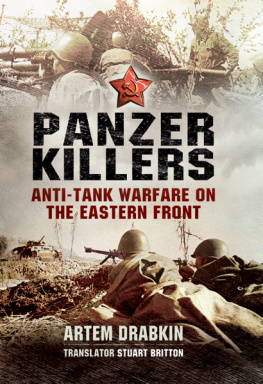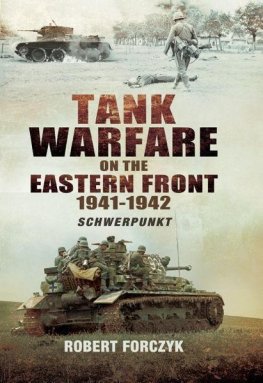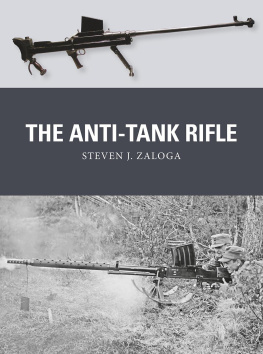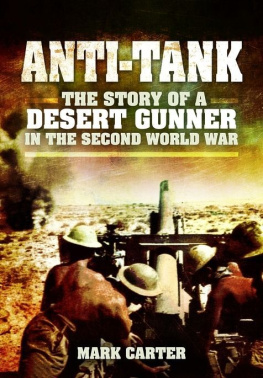First published in Great Britain in 2013 by
Pen & Sword Military
an imprint of
Pen & Sword Books Ltd
47 Church Street
Barnsley
South Yorkshire
S70 2AS
Copyright Artem Drabkin 2013
ISBN 978-1-78159-050-8
EPUB ISBN: 978-1-47382-240-5
PRC ISBN: 978-1-47382-192-7
The right of Artem Drabkin to be identified as Author of this Work has been
asserted by him in accordance with the Copyright, Designs and Patents Act
1988.
A CIP catalogue record for this book is available from the British Library.
All rights reserved. No part of this book may be reproduced or transmitted in
any form or by any means, electronic or mechanical including photocopying,
recording or by any information storage and retrieval system, without
permission from the Publisher in writing.
Typeset in 11/13 Ehrhardt by Concept, Huddersfield, West Yorkshire
Printed and bound in England by CPI UK
Pen & Sword Books Ltd incorporates the Imprints of Pen & Sword Aviation,
Pen & Sword Family History, Pen & Sword Maritime, Pen & Sword Military,
Pen & Sword Discovery, Wharncliffe Local History, Wharncliffe True Crime,
Wharncliffe Transport, Pen & Sword Select, Pen & Sword Military Classics,
Leo Cooper, The Praetorian Press, Remember When, Seaforth Publishing and
Frontline Publishing.
For a complete list of Pen & Sword titles please contact
PEN & SWORD BOOKS LIMITED
47 Church Street, Barnsley, South Yorkshire, S70 2AS, England
E-mail:
Website: www.pen-and-sword.co.uk
Translators Note
The material in this book results from face-to-face interviews conducted between 2001 and 2006 with surviving Red Army veterans who served in the anti-tank artillery. The interviews with Moses Dorman and Mikhail Chernomordik were recorded by Grigory Koifman, who lives in Israel. As expected, the antitank artillerymens roles and paths varied. Some served strictly in the anti-tank artillery, while others began their service in the infantry, or wound up as a self-propelled gun crew member. There are a few notable contributions to this book. Mikhail Borisov became a living legend in the Soviet Union for his actions in front of Prokhorovka on 11 July 1943, where he continued to man and fire a gun alone while helping to repel the attempt by the 1st SS Panzer Regiment to seize Prokhorovka the day before the 5th Guards Tank Armys dramatic counterattack on 12 July. Borisovs actions were witnessed by the commander of the Soviet 2nd Tank Corps, Lieutenant General A.F. Popov. Eager for a heroic role model [particularly one who was a Komsomol member and Russian] to help rebuild the morale after the 2nd Tank Corps battering in the Battle of Kursk, Popov helped secure the title Hero of the Soviet Union for Borisov, then wined and dined him and used him to give pep talks to survivors and new recruits. Two of the contributors, Aleksandr Rogachev and Nikolai Shishkin, are rare representatives of the very few that served from 1941 (or in the latter case, from the Winter War with Finland) right up until the end of the war. The actions span the entire sweep of warfare on the Eastern Front, from Finlands Hanko Peninsula to Stalingrad, and from the gates of Moscow in 1941 to Germany and Czechoslovakia in the wars final days.
The interview process was similar. Each veteran was asked to provide a basic narrative of his service and experiences. At times, the questioner would ask questions to help flesh out the story or to solicit additional information. At the end of the narrative, the questioner would ask follow-up questions, again seeking the veterans thoughts on a variety of topics related to morale, superstitions, equipment, the treatment of captured German soldiers and German civilians, etc. For this English translation, an editorial decision was made to remove the questions and to note new topics of conversation prompted by the question by a line break from the preceding material. This explains some of the choppiness in the text, particularly toward the end of each chapter.
Naturally, over the passage of time since the war ended, the veterans memories began to fade. Some stories remained firmly planted in their recollections, but other details might be lost. The personalities of the veterans also contributed to a diversity in the responses some were simply more taciturn than others, so while their contributions are no less valuable in helping build this mosaic portrait of the Red Army anti-tank artilleryman in the Second World War, they are correspondingly briefer.
When a veteran mentions something that I think may be unknown to the typical Western reader, as the translator I have added brief bracketed comments to the text, or for longer explanations, used end notes to clarify what the veteran is saying.
I want to thank Rupert Harding, chief editor of Pen & Sword, for commissioning this translation and for helping edit the Russian interview material. I also want to thank Pamela Covey for her usual superb proofreading effort that caught any errors missed by a tired translators eye. Of course, any remaining mistakes in translation are mine.
Chapter 1
The Burning Snow of the Pakfront
Aleksei Isaev
Anti-tank artillery appeared soon after tanks arrived on the modern battlefield. At first these were field artillery pieces, allocated for firing at tanks. Grapeshot, through its shock effect, served as the first armour-piercing shell. The time for specially-developed anti-tank guns came after the First World War. The fledgling Workers and Peasants Red Army didnt remain on the sidelines during this process. The System of Artillery and Infantry Arming of the Red Army was adopted as a protocol at a session of the Revolutionary Military Council of the USSR Soviet on 22 May 1929. According to this document, each artillery battalion would be equipped with 37-mm infantry anti-tank cannon for the struggle with enemy armoured vehicles. Since no suitable gun for this purpose was then in domestic production, it was purchased abroad from the Rheinmetall AG firm. The gun was put into service under the designation 37-mm anti-tank gun model 1930 [M1930]. The evolution of this weapon in the 1930s led to the appearance of the 45-mm anti-tank gun with the factory designation 53-K, which became known as the 45-mm anti-tank gun M1937. Thus appeared the gun that became so well known to many as the sorokopiatka [literally, the forty-five-er]. Production of this gun was assigned to Kalinin Factory No. 8 in the Moscow suburb of Podlipky.
One characteristic of the anti-tank gun is the necessity of a high rate of fire. Small-calibre anti-tank guns were effective only out to a range of several hundred metres, so the anti-tank gunners had very little time to knock-out the tanks before they reached their own positions. Therefore the 45-mm anti-tank gun had a semi-automatic, sliding block breech mechanism. After firing a shot, the gun would roll backwards, and the recoil mechanism would return it to its former position. At the end of the counter-recoil cycle, the automatic mechanism would open the breech and eject the empty shell casing. The breech would remain open and the loader could, without wasting time to open it, reload the gun. The quick-firing round forced home by the loader would knock the breech from the toes of the shell-casing ejector, it would close, and the gunner could then send another shell toward the target. Extendable split trails were vital for the anti-tank gun. Such a design in place of the block trail gun mount permitted wide angles of traverse for shifting fire toward various targets. Since tanks could use folds in the ground in order to bypass the antitank gunners positions or break through in the sector of a neighbouring unit, the guns had to be ready to change the direction of fire. Light, small-calibre guns didnt present any difficulties in laying the gun on a new target. For heavy anti-tank guns (57-mm, 76-mm and greater), a gun-crew member stood by each trail, ready to turn the gun.
Next page










